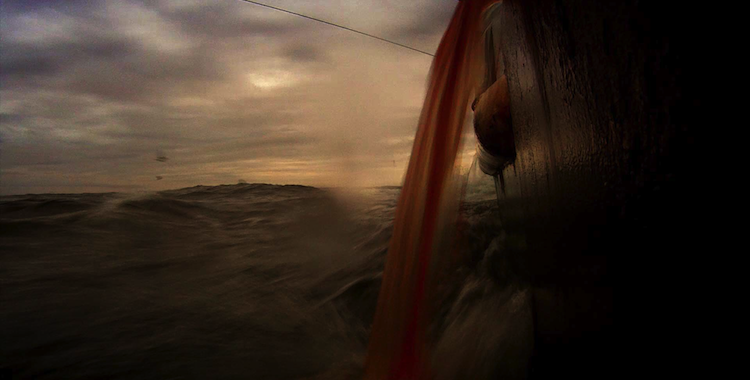We celebrate the end of the year the only way we know how: through lists, essays, and mixes. Join us as we explore the music and films that helped define the year. More from this series
1. TRENDING (HYSTERICALLY)
If there was a notable trend (trend, trend, trend!) in the cinema of the Year of Our Lord 2013, then one could locate it in the sudden irruption of the bombastic within the oft-sleepy confines of the art house. It was most clearly embodied by Nicolas Winding Refn’s Only God Forgives, which was noted both for its aggressive violence (the quintessential content of the bombastic mode) and for its aggressive use of style (its quintessential form), but the earlier months of 2013 saw the release of two arguably diametrically opposed films that nevertheless both encompass the breadth of the tendency: former enfant terribile Harmony Korine’s Spring Breakers and Lucian Castaing-Taylor and Véréna Paravel’s Leviathan, produced through Harvard’s Sensory Ethnography Lab. It should probably be noted that this sort of irruption is hardly unusual, dating back at least as far as the birth of Soviet Russian cinema and probably further. So what, then, makes the current flavor oh so contemporary? (Trend!)
In the mainstream cinema (or whatever), bombast continued as usual, of course, furthering the slow plateau of a tentpole cinema built on technological progressivism that continues at the exponential rate of hard drive capacity, with all the concomitant excitative diminishing returns both industries seem to share. We’ll set those aside. The continuation of a decade-long trend doesn’t tell us much.
2. DEFINITIONS
Bombast is an affective varietal of sensual quality, or at least it is when it comes to film. The term describes a particular reaction to a particular cinematic experience, one that, like its much-abused cousin, “lyricism,” arises neither from the form and content of an individual image nor from its location within a temporal or narrative context. Nevertheless, it is simple and accurate enough to describe bombast as emerging out of a particular, peculiar confluence of the two, which is as easy to describe with a phrase or two as it is difficult to pin down with anything approaching formalist rigor. If lyricism can aptly, if insufficiently, be described as “a series of tranquil film images cut together in a languorous manner,” then it is equally apt to describe bombast as “a series of irruptive film images cut together in an irruptive fashion.” And if the concept of a lyrical cinema has traditionally described a blend of international art film that devotes itself to a sustained mood of quiet contemplation over a healthy meal of elegantly cascading imagery (usually involving nature), then a concept of a cinema of bombast in all likelihood describes one that devotes itself to a violently inconstant mood of incessant (re)stimulation over a gut-wrenching meal of jagged thrusts of imagery (often involving explosions and/or boobs.)
3. IMAGES
At first blush, Spring Breakers and Leviathan share few similarities — the former a Florida-set day-glo confection about breasts and the American Way understandably, if foolishly, marketed to teens, the latter a hardcore piece of “sensory ethnography” detailing the daily goings-on of a fishing boat off the coast of Massachusetts — but the reactions of audiences pointed toward a common syntactical core. Spring Breakers makes use of tropes of the cinema of bombast in a fairly standard way, its thundering score underlining forceful depictions of brutal violence, wanton drug use, and casual sex, while also deploying an excessive array of culturally loaded signifiers to strengthen its overblown affect — Gucci Mane plays a carbon copy of himself, one-time preteen Disney idols defile themselves for a putatively Catholic audience, and James Franco apes RiFF RaFF (even if he continued to claim elsewhere that he was actually drawing inspiration from a far less well-known Floridian rapper called Dangeruss).
 Spring Breakers
Spring Breakers
“Bombastic” is as much a descriptor of affect as it is of content, as much a modality of filmmaking practice and nervous system response as diegesis. It’s the subtle way in which the film draws its editing patterns from both the abstruse filmography of Korine himself and films like Crank 2: High Voltage (2009) that points toward its odd overlap with Leviathan’s ostensibly high-minded investigation of space. Although Spring Breakers was marketed primarily to mainstream teen audiences (amusingly and appropriately by A24 Films in coordination with VICE Media), it’s no wonder that it found its most appreciative audience in the more youthful end of the vaguely art house market, slotting it neatly into the scope of our analysis.
4. MORE IMAGES
It’s not Spring Breakers’ cornucopia of breasts and heavy weaponry that tag it as a member of our emergent trend, but the manner in which those breasts were offered up for our enjoyment. How were the breasts like a boat full of dead fish? Opening scenes tend to contain the purest expression of a film’s guiding formal principles, and Spring Breakers opens with a montage sequence of a beach party shot on hyper-saturated 35mm, beer poured from replacement phalluses into gaping mouths and jacked-up breasts bouncing in slow motion. The sky is very, very blue. Set to Skrillex’s massive hit “Scary Monsters and Nice Sprites” with its recurring “Oh, my God!” interjections and car crash transitions, it plays out in luxurious drifting shots, cut together in true montage fashion, with little to no allowances made to continuity editing and maintaining only a tenuous relation to space. It ends with a harsh cut timed to a sound effect of a pistol cocking.
Leviathan, on the other hand, begins with a long take, a hazy digital smear of black slowly giving way to a bright smudge of red that reveals itself as the rain jacket of a crewmember hauling ropes out of the ocean. The sound is horrifically harsh, digital recordings peeking into the red. The bombast here is in the almost mythic emergence of the throbbing and convulsing environment of turbulent water groaning out of the gaping abyss, an effect heightened by the darkness it emerges from. If Hans Zimmer, he of Inception (2011), Pirates of the Caribbean: Dead Man’s Chest (2003), and, all-too-fittingly, 12 Years a Slave fame, is the reigning king of bombastic soundtracking, the reason is clear — like Skrillex and the innate aural production arising from the interplay of sea and machinery, he plays thundering percussion and kinetic melodies against relative silence. Blunt emotional capacities. Contrast.
 Leviathan
Leviathan
Castaing-Taylor and Paravel’s link to our trend becomes clearer later, as the film devotes increasingly long amounts of time to finding extremely unusual ways to film dead fish. The resultant images of a camera cast aside without operator into a pile of fish heads is at once categorically bombastic — dead fish/strange angle/too close — and bombastic on a level of meta-play — the postmodern trope of the camera released from the artist in its goriest form.
5. IDIOT POETICS
At the same time, the relation of the bombastic to melodrama is clear, as is the divergence: melodrama arises from an overabundance of character and conflict, bombast from an overabundance of visual and aural stimuli. Dumb level affect. But Leviathan is not Dead Man’s Chest, nor is it Xavier Dolan’s transwoman epic Laurence Anyways, arguably another example of 2013’s flirtation with the overblown and a stunning piece of filmmaking in its own right, but one that nevertheless slots more into the continuity of the melodramatic tradition than it does with a “pure” system of bombast. The difference is located in editing practice, in the disregard for special continuity. Action bombast locks us into a narrative and spatial space for the sake of clarifying kinetic through lines, but for all the kineticism of Spring Breakers and Leviathan’s cinematic styles, neither makes much room for continuous action across shots, leaning more toward our lyrical style of cutting. One could call it an intellectual montage pattern, excepting for the fact that neither film makes any particular direct appeal to an intellectual analysis across cuts, but rather one built on the images themselves and their immediate affective power.
Opening the scope of our analysis to return to Only God Forgives and to include Claire Denis’ 2013 film Bastards, the implications become clearer, as do the particular differences between years of bombastic art house and previous examples of the same, such as much of Godard’s later output, with its use of loaded imagery and the sudden irruptions of unmotivated titles and sound cues keyed explicitly to furthering intellectual arguments. Only God Forgives comes pre-loaded with an intellectual theme, to be sure, but it’s such an amusingly first-level Freudian one — Gosling avenges his brother’s death so that he can fuck his mother’s gaping womb/womb — that any attempts to read the film through such a lens flounder in obviousness. The film’s power, when it manages any, arises instead via rendering its themes in monolithic terms through a slow-boil approach to montage and a baroque sense of production design. Single-minded overdeployment of thematics as bombast.
 Only God Forgives
Only God Forgives
 Bastards
Bastards
Bastards, meanwhile, refuses a traditional involvement with its seedy thriller plot through a resolutely elliptical approach to narrative editing. But it also avoids the promise of pure bombast by withholding any images that openly display a gothic intensity prior to its final montage of lo-res digital shots of sexual depravity and exploitations, which rip the film away from its dully tasteful Euro-art house traditions into a far more complicated, if far more direct, appeal to the gag reflex.
If there’s anything these films share, it’s a melding of the kinetics and ruptures of bombast with a digressive and, well, lyrical style, as summed up by the trailer to Sofia Coppola’s The Bling Ring (also 2013), which, set to Sleigh Bells’ “Crown on the Ground” and featuring no-good teens and an aggressively foregrounded but besides-the-point plot, almost out Spring Breaker‘d Spring Breakers itself.
6. SENSUALITY
On one level, it’s still post-2000, and we’re still mired in genre-fuck games, where film genres smoosh together as easily as musical ones. But why did we respond so strongly to these particular examples, at least at websites like this? Was it just that the combination was still fresh enough to push new buttons? Or was there a political and/or aesthetic resonance beyond that? At first blush, the political is out the window — Spring Breakers makes a show of forgoing the political for a newfound engagement with the sensual, and Leviathan avoids making what would seem to be obvious statements about mechanized food production for the sake of spatial interrogation — and any aesthetic “progress” in these films is easily written off as the aforementioned genre play.
The answer, perhaps, lies in a concept of the sensual experience as the ultimate goal of these films, with the adoption of various modes as the means rather than the end, and bombastic tendencies becoming the means through which these modes are channeled toward a highly specific end. Only God Forgives is a thriller as thriller more than it actually thrills; Spring Breakers is one of the most fully boob- and violence-oriented films in the history of the form; and Leviathan is about the sensations a fish boat creates rather than any function a fishing boat might have. The Bling Ring, at its best moment, approximates the joys of teen theft, and even Bastards is only successful when it finally becomes a snuff film rather than a film about snuff films. The lyrical and digressive qualities of these films function as much to evade direct sociopolitical interpretation as they do narrative ones. The proverbial “takeaway,” such as it is, is all surface, but it feels commendably so.
7. WHAT FLESH?
Sex and violence, in this case, are notable not because of cultural associations with transgression or depravity, but because their definition is one largely composed of sensual qualities and affects. An obsession with violence and gore is in no way a notable trend in the cinema in any year, either in the art house or otherwise, but what made a subsection of this year’s films distinct was their infatuation with what sex and violence feels like. There’s no point in hailing a lack of political engagement as the new frontier, but by the same token, it’s hard to find a film this year that threw itself into issues of race, gender, and the military-entertainment complex more deeply than Spring Breakers, save maybe Lee Daniel’s The Butler. There’s a sticky core to the hedonism and willful disengagement of this year’s crop of art house bombast that points toward a circumspect way of approaching the fragmented first-world zeitgeist, and that core has something to do with a notion of sensual specificity.
 Spring Breakers
Spring Breakers
 Leviathan
Leviathan
Spring Breakers channels its sensuality through a particular intersection of an array of US stratifications — race/gender/class/subculture/etc. — and Leviathan’s single-minded focus on exploring the space of one specific boat ties its affective qualities to a particular experience of that particular space. In both cases, this localization feeds back onto the mode of its portrayal, and the result are films at once void of intellectual argument and yet almost ludicrously “faithful” to its source. Complicating matters is the fact that this “source” is nevertheless highly qualified — an Orientalist vision of Thailand, pop culture’s image of Miami, the filmmaker’s/academic’s conceptualization of a fishing boat — and the loop feeds back over and on itself once again. What’s left, then, is a high localized sensuality nevertheless unbound from any lived experience and caught up in pop culture’s torque — yes, even Leviathan.
An infatuation with surfaces. The confusion of pop pleasure and lyrical drift. The retreat from the transcendent functions of film into the immanent and then tossed into the flows of bombastic pleasure. If there’s a philosophical outlook these films share, it’s certainly nihilism, with their rejection of meaning in favor of the brutal here and now, and the films, with their resolute primacy of sensuality, also share the tendency of the best strains of nihilism in burying themselves in context while abnegating the transcendent possibilities inherent in attaching outside contexts to brute truths.
8. (FAUX) FINALITY
And so, yes, these films are hopeless even as they revel in their glorious and/or horrific sense-scapes, their closed worlds. Another function of bombast, not yet discussed, is its encompassing tendencies, the directional fullness of its emotive aesthetics. These films posit sensorially complete worlds, empty of meaning even as they are full of resonance and context. And ultimately, that was perhaps both their power and why they resonated in 2013, far too long into the lifespan of an artform that, despite its continued massive popularity, often seems to be on the verge of creative death. In some way, they return to the central and deeply simple function of film and its power to evoke — for the sake of pat and inaccurate cohesion, let’s briefly mention Lumière and his stunning train station of 1895 — while taking as their content the desperate complexity of an unknowable present.
Our (“depraved”) sex, our dead fish, our genre-tagged murder, and our insatiable desire for entertainment — the last, crucially — are the subject of these films. But these subjects are found not in an extratextual aspect, but in their material unfolding. And that material, unsurprisingly and appropriate for its bombastic frame, is age-old shock elements, still alive and kicking. In the case of most of these films, it was more of an attempt at a mode rather than a successful embodiment of one, but all of these films were nevertheless this year’s best approaches to the monstrous and sublimated sensualities of the present in our aging cinema.

We celebrate the end of the year the only way we know how: through lists, essays, and mixes. Join us as we explore the music and films that helped define the year. More from this series
